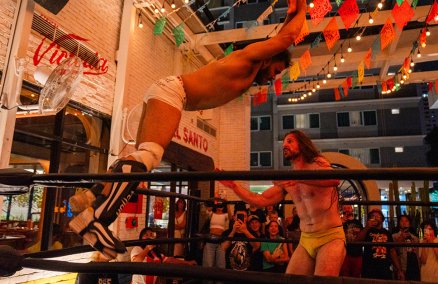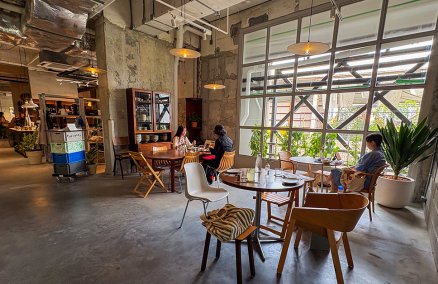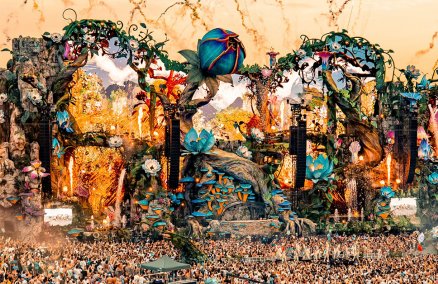THA TIEN-PHAHURAT-YAOWARAT
If you’re all about capturing the fading charms, old architecture and slow-life vibe of Bangkok’s Old Town, then look no further than the historic neighborhoods of Tha Tien, Phahurat and Yaowarat. Start your journey at colonial-style The Old Siam Plaza on Tri Phet Road near MRT Sam Yot, known for its great selection of traditional Thai desserts—try the kanom kuy chai (steamed dumplings) and kanom buang (crispy pancakes with sweet or salty stuffing)—Thai silk and, surprisingly, a whole floor dedicated to firearm shops. Then, cross the road and make your way down Soi Thip Wari, which connects to Ban Mo Road—known for its shops specializing in electronic parts and audio equipment. Keep walking until you reach Charoenkrung Road. From here, continue on until you get to the tranquil and picturesque Atsadang Road, which runs alongside Rop Krung Canal. Here, you can capture the dilapidated beauty of the area’s historic King Rama V-era Sino-Portuguese architecture. Cross the canal and about a two-minute walk away you’ll find the neoclassical Territorial Defense Command headquarters located on the corner of Sanam Chai Road. As you stroll down Soi Thai Wang, you’ll be treated to glittering views of The Grand Palace and Wat Pho, currently devoid of the usual sunburned, shouting, fleshy masses. Once you get to Tha Tien Pier, escape the sun by cutting through Tha Tien Market and work your way towards the shophouses filled with cafes lining Maha Rat Road. Find a seat upstairs at Ha Tien Cafe and cool down with a refreshing Americano Yuzu (B110) and a slice of carrot cake (B180). If, by this time, dinner is on your mind, then hop over to Yaowarat. As you make your way there, you’ll pass through Phahurat, or Little India, home to photogenic textile, fabric and silk shops, as well as the golden-domed Gurdwara Siri Guru Singh Sabha temple. After about a 15-minute walk, you can end your day chowing down on the famous guay jub (rice noodles in five-spice broth) at Michelin Bib Gourmand-recognized Guay Jub Uan Pochana (in front of China Town Rama Cinema)—the same tender but chewy noodles, aromatic and peppery broth, and juicy, crispy pork belly, but now with plastic dividers and a fraction of the crowds.
TALAD NOI
Start outside the Thai Fishsauce Factory (Squid Brand) close to River City on Charoenkrung Soi 24, where you can’t miss street artist Jayoto’s towering bright yellow mural, featuring colorful Talad Noi locals and cats. Continue straight down the narrow Wanit Soi 2 alleyway until you hit the mini roundabout outside the Holy Rosary Church. Here, you’ll find remnants of Bangkok Design Week (BKDW) in a silver dragon made out of spoons and kitchen utensils. If you’re hungry, take a right up Yotha Road to fill up on delicious nam prik dishes (from B100) at Krok, from the team behind Michelin-starred 80/20. Further down Wanit Soi 2, you’ll find Soi San Chao Rong Kueak on your left, which draws you into the heart of one of Bangkok’s oldest and most charming neighborhoods: Talad Noi. On the right side, the passageway is lined with a photo exhibition leftover from BKDW, featuring images of the historic neighborhood, while the left is covered in colorful paintings, many of which reference the area’s Thai-Chinese heritage. Walk past the frozen-in-time houses painted with whimsical murals and you’ll reach the faded Chinese Rong Kuak Shrine on the riverside. Opposite, don’t miss Mother Roaster, the photogenic coffee shop located above a car parts scrap shop and run by a hip septuagenarian barista. If you’re in the mood for something stronger, follow the road around and you can grab a cold beer (once the ban is lifted) at the chilled-out riverside Baan Rim Naam. Check out The So Heng Tai Mansion, a nineteenth-century Chinese courtyard house continuously inhabited by the man who had it built 200 years ago, Phra Aphaiwanit, before continuing along the circular route onto Soi Chao Sua Son. Here, you’ll find a black cat painted on the wall, one of many playful works that interacts with the surrounding environment—bonus points if you can get one of the many local street cats to pose next to it. Further along, be sure to look out to your right, as the side-soi is licked with some of the area’s most impressive artwork, including a girl with a fan, a dragon and a fat white cat. At the end of the street, you’ll be drawn towards many more of the area’s iconic car parts shops, where mountains of rusty parts spill out onto the road. From there, get lost in the labyrinth of back alleys or continue walking until you reach Song Wat Road, where you’ll find plenty more cool street art, including a fading yet provocative work by Belgian artist Roa of two elephants performing acrobatics and a realistic mural of motorbike drivers waiting for their next ride.
SAMYAN
Besides its legendary local food, Samyan is teeming with old-school 1960s shop-houses—made all the cooler by their juxtaposition with newcomers like Samyan Mitrtown. Head to the mall’s underground floor to strike a pose in what is perhaps Bangkok’s coolest walkway, the industrial-style passageway leading to MRT Samyan Station. Then, head to exit 1, where you’ll pop up at the always bustling Thai-Chinese Wat Hua Lamphong. Walk up towards the temple to snap its interior and intricately designed temple roof. Then, walk towards the naturally shady Si Phraya Road, where you’ll find old shophouses turned into barbers, tailors and neighborhood food institutions like Sawang Noodles Shop. Walk right towards Song Phra Road, where you’ll find a clan of mototaxi drivers stationed outside a 7-Eleven. On this predominantly residential soi you’ll find even more vintage, two-to-three-story shophouses. Walk towards Soi Chom Sombun, and you’ll pop out at Rama IV Road. On the right, you’ll find the Dubai-worthy Ideo Q Chula-Samyan condo (which sort of resembles a USB drive, if you squint). Cross the road to Chula Soi 42 for an energizing Coffee Beer Float (espresso, rootbeer and soft serve; B160) at Brave Roasters Samyan. Then head to ZY Walk, a commercial complex that houses an impressive cluster of Sino-Portuguese-style buildings. Here, you’ll strike gold. In the courtyard upstairs, where red-and-blue walls and Chinese-style murals create endless photo opportunities, you’ll feel like you’re on the set of an old Chinese period drama. If you’re burned out and/or red in the face from all the walking in the hot summer sun, drop into I’m Park next door for an array of dining options before your ride back home.
HUA TAKHE
Despite it being located deep in the ‘burbs, getting here is not as hard as you think. Just take the Airport Rail Link to Lat Krabang station, then hop on the rod songthaew (red bus) to Lat Krabang Soi 17 and you’re good to go. Before hitting the old market, make a stop at Ha Heng Tua and Tien Poh Hook Tueng for some shots of the idyllic Chinese shrines. Continue your walk to the end of soi 17 and you’ll see the bridge to the Hua Takhe Old Market; to your right, you’ll find some cool graffiti of a monkey and a crocodile. When you walk across the bridge, there will be two pathways—explore the left side first. Check out the area’s oldest school, Suksa Pattana, and the cluster of quaint mom and pop shops, then just follow the pathway to see more street art. At this point, you’ll probably be wondering “what’s with all the crocodile murals?” Here’s the boiled-down history: decades ago, this area used to be home to crocodiles, which is how it gained its name, Hua Takhe or “Crocodile Head.” Take note of the charming ramshackle wooden shophouses—they’re more resilient than you might think. Having caught on fire twice, it’s a miracle that they’re still standing. Once you’ve filled up your memory card with photos, do a 180 and take a stroll to the other side. Starving? You can fuel up on noodles (from B40) from the riverside Guay Tiew Rong Gueng, located opposite the machine shop (rong gueng). Wrap up your trip at the down-to-earth Glin Fun with its Thai blend coffee (from B50) and good-humored owner. Grab a table by the water to enjoy the scenery of the fourway canal intersection. The next thing you know, you might end up repotting their cacti, like we did.
THONGLOR
Sukhumvit Soi 51 has been a hotbed for indie art since WTF opened in 2010. Today, the bar-slash-gallery has turned the alley walls into a living installation, plastered with posters and graffiti documenting doomsday (more info about that exhibition here). WTF is also serving snacks like Thai Yai popcorn (B130) and beers (B120) to go. Check out the parking lot behind the the bar, Studio Lam and Zudrangma Records to find some cheeky street art of Uncle Tu. From here, thread your way through the graffiti-lined alleyway between Sukhumvit and Bangkok Prep as you walk back to Thonglor (Sukhumvit Soi 55). The neighborhood has changed a lot over the years, but the Mae Varee mango sticky rice stall is still there at the front of the soi, crying out for you to photograph it. Speaking from experience, it is much easier to do that without crowds of people fondling all the mangoes. Further up the road, stop by the tiny soi behind Rabbit Hole for a drink break at Black Amber; currently, the team is selling homemade ya dong cocktails (B180) to go. Refreshed and refueled, navigate the back alleys to find The Missing Burro on Thonglor Soi 7. Order some carnitas (B290) as you steal shots of its double shipping container set-up and sanctuary-like lawn, and then continue down the soi toward R.Haan. Around here, you’ll find weather-worn gates that front leafy compounds owned by Bangkok’s old money, as well as Japanese supermarkets, bars and restaurants—disparate trademarks of this ever-changing community. Check out the parking lot by Iroha Yakiniku to find more photogenic wall art. As of Jun 1, The Commons will be open for business, so you can pop in for an iced latte at Roots (B120), a beer (to go… ?) from The Beer Cap or a bite to eat before working your way up Thonglor to photograph the Masjid Zhohirul Islam. At night, the mosque is bathed in green light, but even by day, Thonglor’s hub for the Muslim community is a site worth capturing on film (or your DSLR). Further up, photograph Bangkok’s disappearing Brutalist buildings before you end your tour at the Saen Saep Canal, where you can take shots of bicyclists and runners maneuvering down the walkway between motorbike taxis. Wait for the canal boat to pull into station to see fine examples of social distancing in action, and then end your tour of the city’s nightlife district at the canalside fresh market that everyone forgets exists.















